King's Own Institute: Consultant Turnover Analysis Report
VerifiedAdded on 2022/11/09
|11
|3384
|419
Report
AI Summary
This report examines the high turnover rate of consultants at XYZ Training Consultancy, focusing on the shift in leadership from Tim to Fiona and its impact on employee engagement and motivation. It explores the application of Employee Engagement Theory, organizational justice, and equity theory to understand the consultants' behavior and dissatisfaction. The report highlights unsuitable leadership instances by Fiona, contrasting her approach with her father's, and analyzes the cultural, ethical, and social concerns that limited her leadership effectiveness. It identifies immediate changes needed to improve staff engagement, such as fostering informal communication, reinstating wellness initiatives, and providing competitive compensation. The analysis provides a comprehensive overview of the factors contributing to consultant turnover and offers practical recommendations for improving employee retention and creating a more positive work environment. The report concludes by emphasizing the need for Fiona to adopt strategies that promote trust, respect, and fairness to improve the work life of the employees.
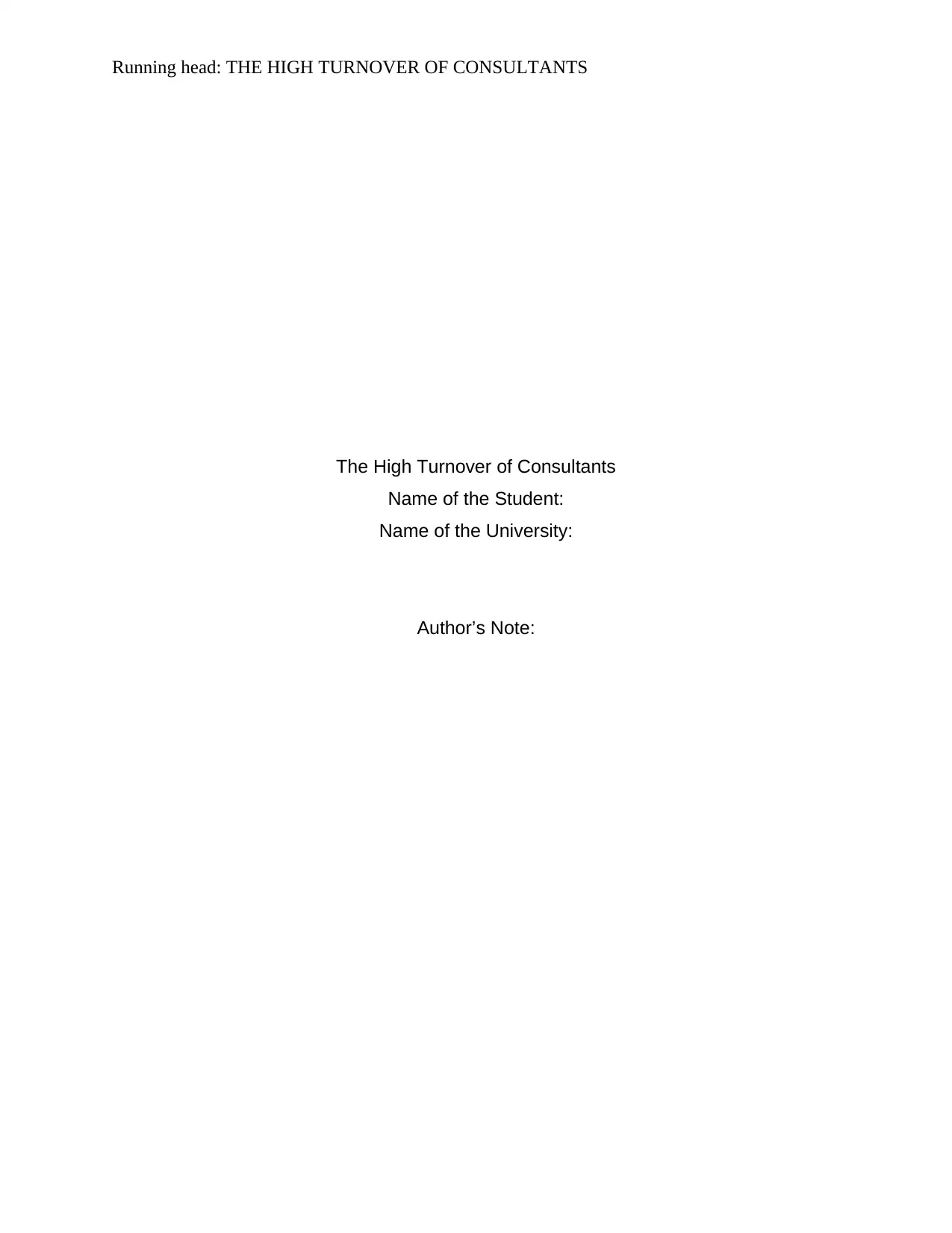
Running head: THE HIGH TURNOVER OF CONSULTANTS
The High Turnover of Consultants
Name of the Student:
Name of the University:
Author’s Note:
The High Turnover of Consultants
Name of the Student:
Name of the University:
Author’s Note:
Paraphrase This Document
Need a fresh take? Get an instant paraphrase of this document with our AI Paraphraser
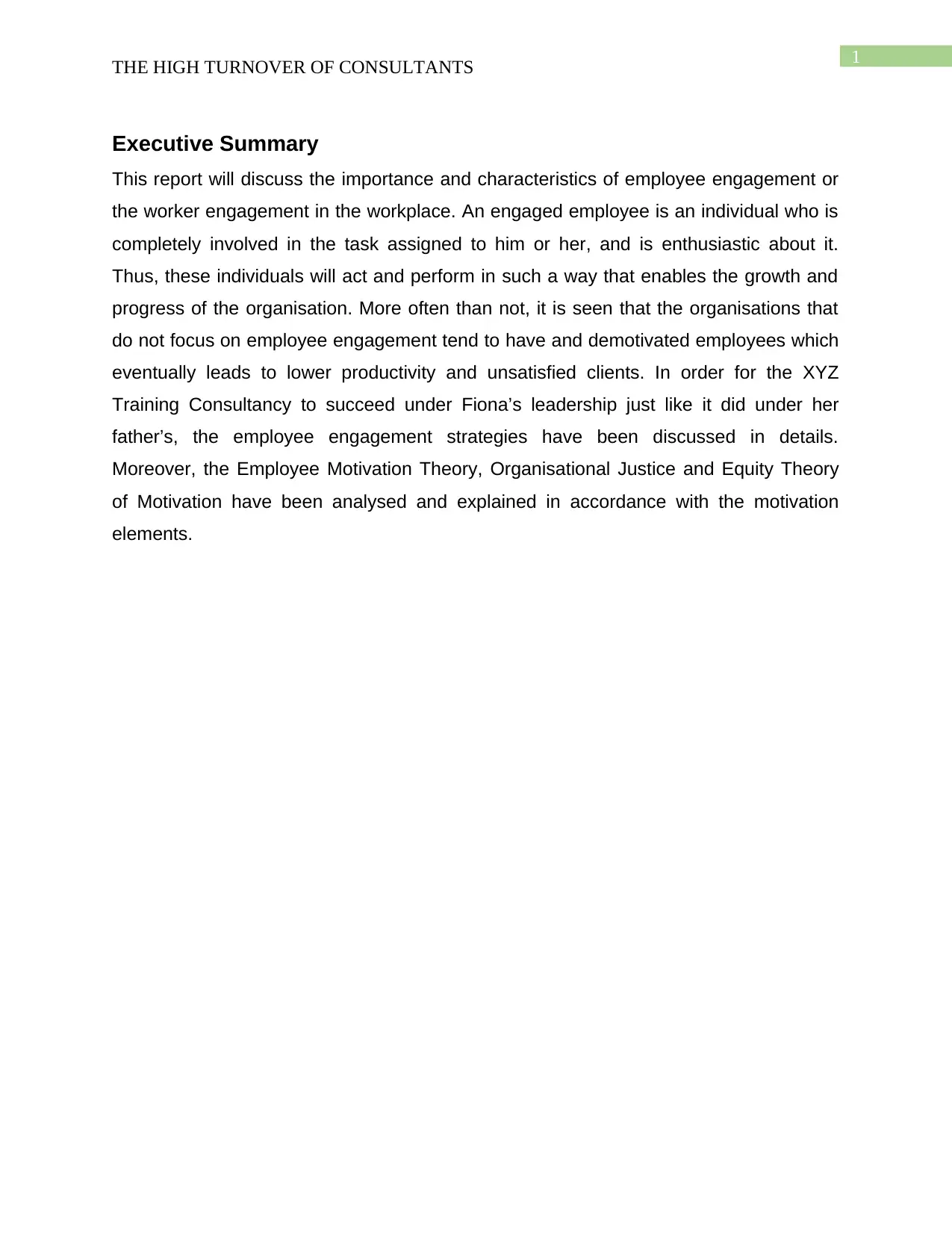
1
THE HIGH TURNOVER OF CONSULTANTS
Executive Summary
This report will discuss the importance and characteristics of employee engagement or
the worker engagement in the workplace. An engaged employee is an individual who is
completely involved in the task assigned to him or her, and is enthusiastic about it.
Thus, these individuals will act and perform in such a way that enables the growth and
progress of the organisation. More often than not, it is seen that the organisations that
do not focus on employee engagement tend to have and demotivated employees which
eventually leads to lower productivity and unsatisfied clients. In order for the XYZ
Training Consultancy to succeed under Fiona’s leadership just like it did under her
father’s, the employee engagement strategies have been discussed in details.
Moreover, the Employee Motivation Theory, Organisational Justice and Equity Theory
of Motivation have been analysed and explained in accordance with the motivation
elements.
THE HIGH TURNOVER OF CONSULTANTS
Executive Summary
This report will discuss the importance and characteristics of employee engagement or
the worker engagement in the workplace. An engaged employee is an individual who is
completely involved in the task assigned to him or her, and is enthusiastic about it.
Thus, these individuals will act and perform in such a way that enables the growth and
progress of the organisation. More often than not, it is seen that the organisations that
do not focus on employee engagement tend to have and demotivated employees which
eventually leads to lower productivity and unsatisfied clients. In order for the XYZ
Training Consultancy to succeed under Fiona’s leadership just like it did under her
father’s, the employee engagement strategies have been discussed in details.
Moreover, the Employee Motivation Theory, Organisational Justice and Equity Theory
of Motivation have been analysed and explained in accordance with the motivation
elements.
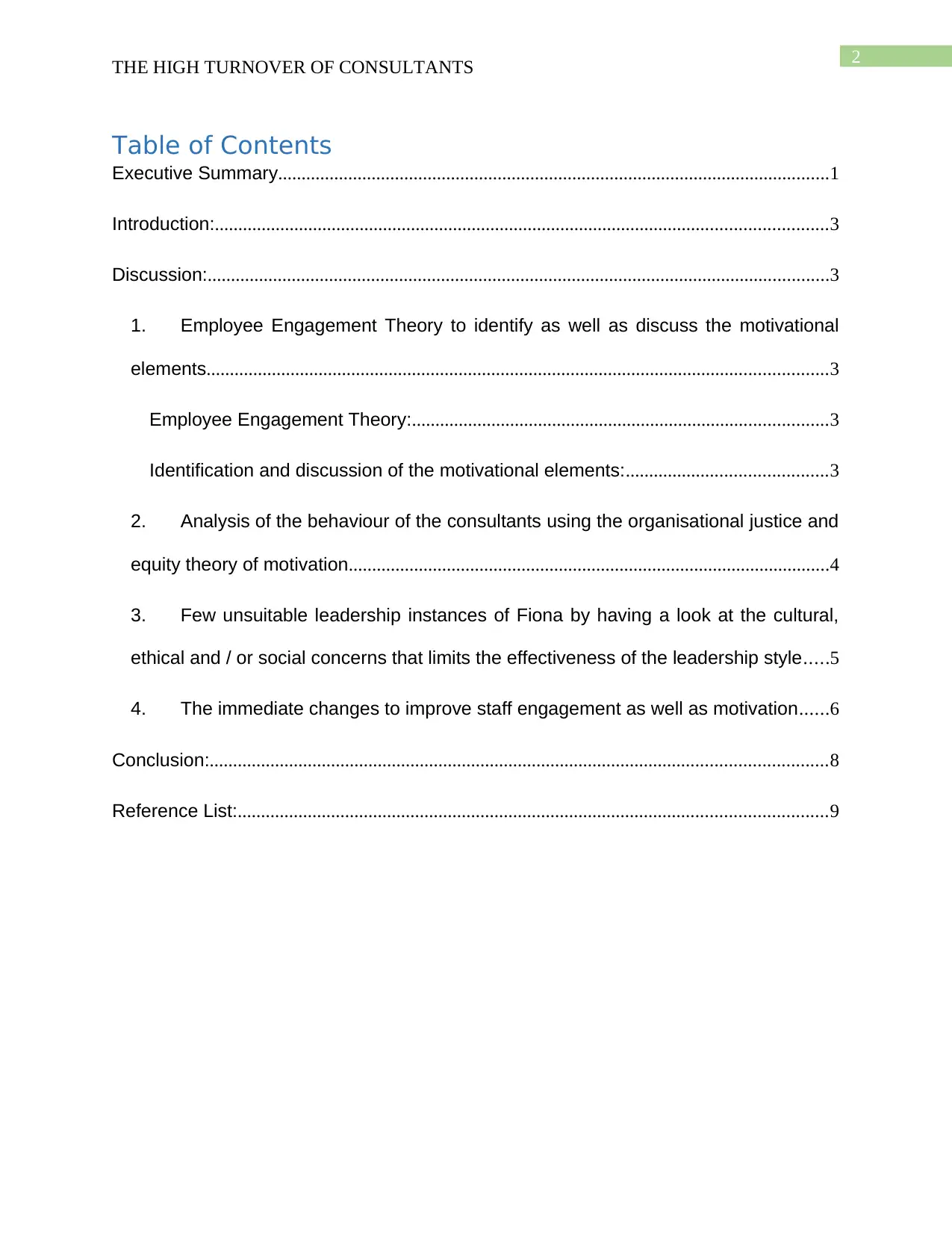
2
THE HIGH TURNOVER OF CONSULTANTS
Table of Contents
Executive Summary......................................................................................................................1
Introduction:...................................................................................................................................3
Discussion:.....................................................................................................................................3
1. Employee Engagement Theory to identify as well as discuss the motivational
elements.....................................................................................................................................3
Employee Engagement Theory:.........................................................................................3
Identification and discussion of the motivational elements:...........................................3
2. Analysis of the behaviour of the consultants using the organisational justice and
equity theory of motivation.......................................................................................................4
3. Few unsuitable leadership instances of Fiona by having a look at the cultural,
ethical and / or social concerns that limits the effectiveness of the leadership style.....5
4. The immediate changes to improve staff engagement as well as motivation......6
Conclusion:....................................................................................................................................8
Reference List:..............................................................................................................................9
THE HIGH TURNOVER OF CONSULTANTS
Table of Contents
Executive Summary......................................................................................................................1
Introduction:...................................................................................................................................3
Discussion:.....................................................................................................................................3
1. Employee Engagement Theory to identify as well as discuss the motivational
elements.....................................................................................................................................3
Employee Engagement Theory:.........................................................................................3
Identification and discussion of the motivational elements:...........................................3
2. Analysis of the behaviour of the consultants using the organisational justice and
equity theory of motivation.......................................................................................................4
3. Few unsuitable leadership instances of Fiona by having a look at the cultural,
ethical and / or social concerns that limits the effectiveness of the leadership style.....5
4. The immediate changes to improve staff engagement as well as motivation......6
Conclusion:....................................................................................................................................8
Reference List:..............................................................................................................................9
⊘ This is a preview!⊘
Do you want full access?
Subscribe today to unlock all pages.

Trusted by 1+ million students worldwide
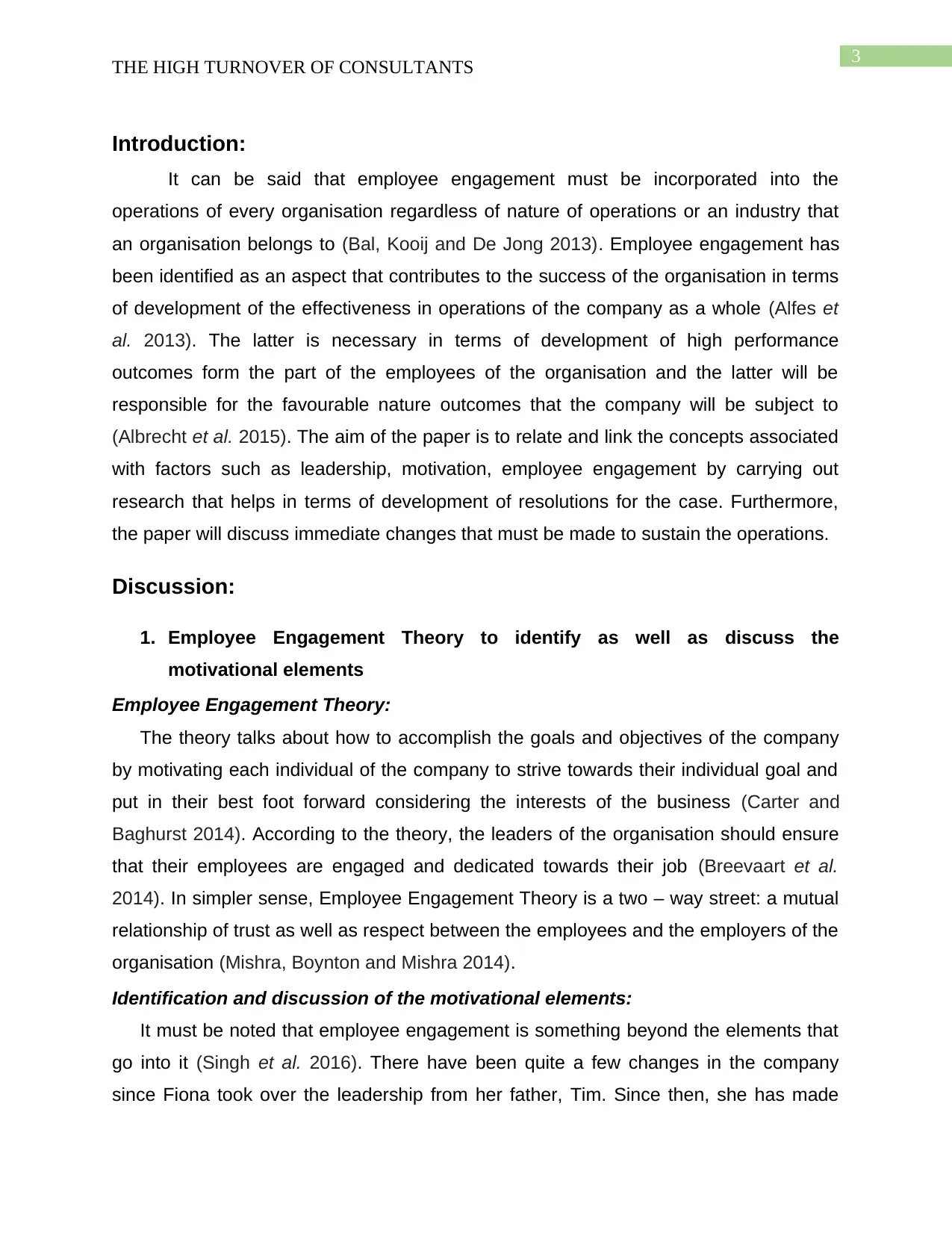
3
THE HIGH TURNOVER OF CONSULTANTS
Introduction:
It can be said that employee engagement must be incorporated into the
operations of every organisation regardless of nature of operations or an industry that
an organisation belongs to (Bal, Kooij and De Jong 2013). Employee engagement has
been identified as an aspect that contributes to the success of the organisation in terms
of development of the effectiveness in operations of the company as a whole (Alfes et
al. 2013). The latter is necessary in terms of development of high performance
outcomes form the part of the employees of the organisation and the latter will be
responsible for the favourable nature outcomes that the company will be subject to
(Albrecht et al. 2015). The aim of the paper is to relate and link the concepts associated
with factors such as leadership, motivation, employee engagement by carrying out
research that helps in terms of development of resolutions for the case. Furthermore,
the paper will discuss immediate changes that must be made to sustain the operations.
Discussion:
1. Employee Engagement Theory to identify as well as discuss the
motivational elements
Employee Engagement Theory:
The theory talks about how to accomplish the goals and objectives of the company
by motivating each individual of the company to strive towards their individual goal and
put in their best foot forward considering the interests of the business (Carter and
Baghurst 2014). According to the theory, the leaders of the organisation should ensure
that their employees are engaged and dedicated towards their job (Breevaart et al.
2014). In simpler sense, Employee Engagement Theory is a two – way street: a mutual
relationship of trust as well as respect between the employees and the employers of the
organisation (Mishra, Boynton and Mishra 2014).
Identification and discussion of the motivational elements:
It must be noted that employee engagement is something beyond the elements that
go into it (Singh et al. 2016). There have been quite a few changes in the company
since Fiona took over the leadership from her father, Tim. Since then, she has made
THE HIGH TURNOVER OF CONSULTANTS
Introduction:
It can be said that employee engagement must be incorporated into the
operations of every organisation regardless of nature of operations or an industry that
an organisation belongs to (Bal, Kooij and De Jong 2013). Employee engagement has
been identified as an aspect that contributes to the success of the organisation in terms
of development of the effectiveness in operations of the company as a whole (Alfes et
al. 2013). The latter is necessary in terms of development of high performance
outcomes form the part of the employees of the organisation and the latter will be
responsible for the favourable nature outcomes that the company will be subject to
(Albrecht et al. 2015). The aim of the paper is to relate and link the concepts associated
with factors such as leadership, motivation, employee engagement by carrying out
research that helps in terms of development of resolutions for the case. Furthermore,
the paper will discuss immediate changes that must be made to sustain the operations.
Discussion:
1. Employee Engagement Theory to identify as well as discuss the
motivational elements
Employee Engagement Theory:
The theory talks about how to accomplish the goals and objectives of the company
by motivating each individual of the company to strive towards their individual goal and
put in their best foot forward considering the interests of the business (Carter and
Baghurst 2014). According to the theory, the leaders of the organisation should ensure
that their employees are engaged and dedicated towards their job (Breevaart et al.
2014). In simpler sense, Employee Engagement Theory is a two – way street: a mutual
relationship of trust as well as respect between the employees and the employers of the
organisation (Mishra, Boynton and Mishra 2014).
Identification and discussion of the motivational elements:
It must be noted that employee engagement is something beyond the elements that
go into it (Singh et al. 2016). There have been quite a few changes in the company
since Fiona took over the leadership from her father, Tim. Since then, she has made
Paraphrase This Document
Need a fresh take? Get an instant paraphrase of this document with our AI Paraphraser
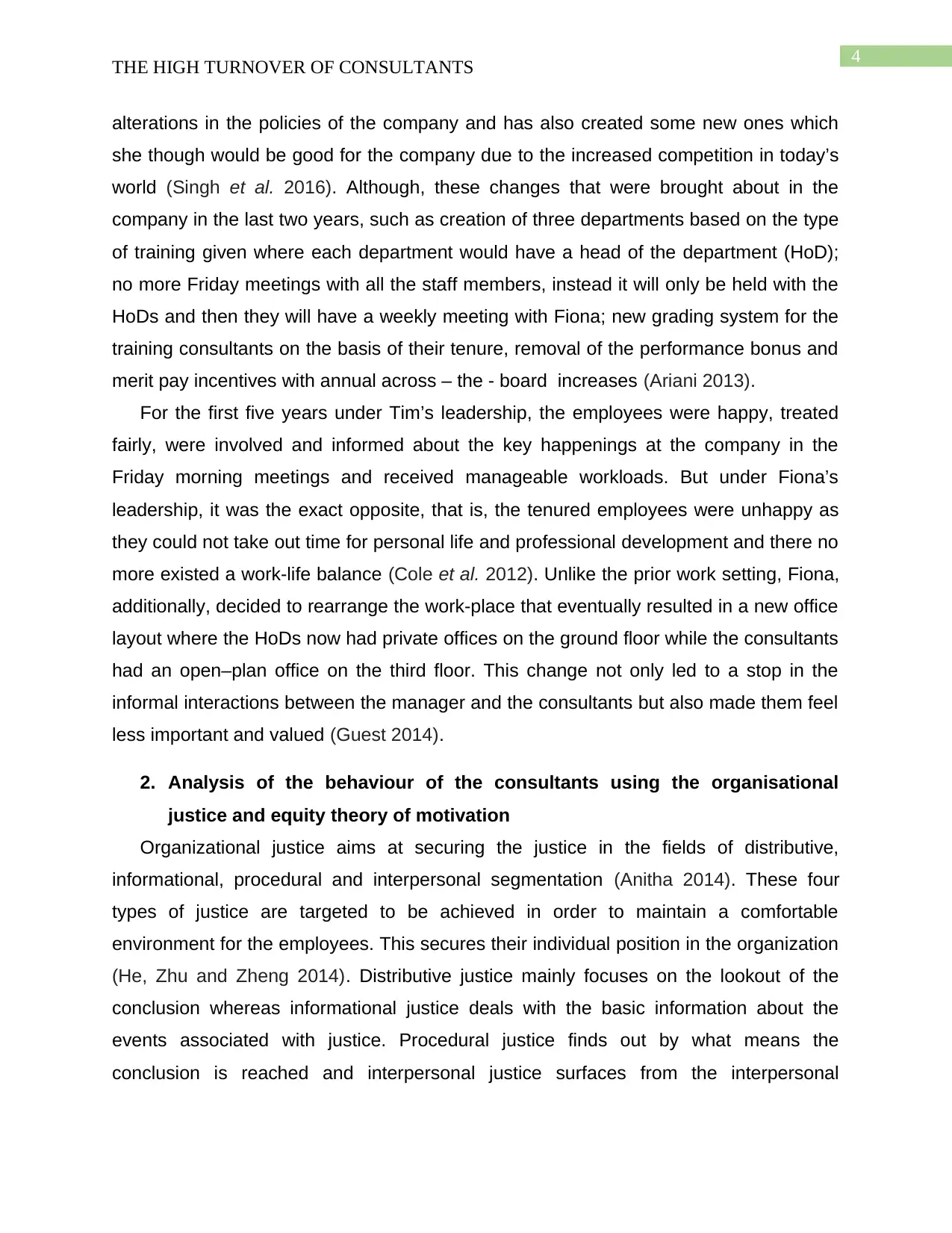
4
THE HIGH TURNOVER OF CONSULTANTS
alterations in the policies of the company and has also created some new ones which
she though would be good for the company due to the increased competition in today’s
world (Singh et al. 2016). Although, these changes that were brought about in the
company in the last two years, such as creation of three departments based on the type
of training given where each department would have a head of the department (HoD);
no more Friday meetings with all the staff members, instead it will only be held with the
HoDs and then they will have a weekly meeting with Fiona; new grading system for the
training consultants on the basis of their tenure, removal of the performance bonus and
merit pay incentives with annual across – the - board increases (Ariani 2013).
For the first five years under Tim’s leadership, the employees were happy, treated
fairly, were involved and informed about the key happenings at the company in the
Friday morning meetings and received manageable workloads. But under Fiona’s
leadership, it was the exact opposite, that is, the tenured employees were unhappy as
they could not take out time for personal life and professional development and there no
more existed a work-life balance (Cole et al. 2012). Unlike the prior work setting, Fiona,
additionally, decided to rearrange the work-place that eventually resulted in a new office
layout where the HoDs now had private offices on the ground floor while the consultants
had an open–plan office on the third floor. This change not only led to a stop in the
informal interactions between the manager and the consultants but also made them feel
less important and valued (Guest 2014).
2. Analysis of the behaviour of the consultants using the organisational
justice and equity theory of motivation
Organizational justice aims at securing the justice in the fields of distributive,
informational, procedural and interpersonal segmentation (Anitha 2014). These four
types of justice are targeted to be achieved in order to maintain a comfortable
environment for the employees. This secures their individual position in the organization
(He, Zhu and Zheng 2014). Distributive justice mainly focuses on the lookout of the
conclusion whereas informational justice deals with the basic information about the
events associated with justice. Procedural justice finds out by what means the
conclusion is reached and interpersonal justice surfaces from the interpersonal
THE HIGH TURNOVER OF CONSULTANTS
alterations in the policies of the company and has also created some new ones which
she though would be good for the company due to the increased competition in today’s
world (Singh et al. 2016). Although, these changes that were brought about in the
company in the last two years, such as creation of three departments based on the type
of training given where each department would have a head of the department (HoD);
no more Friday meetings with all the staff members, instead it will only be held with the
HoDs and then they will have a weekly meeting with Fiona; new grading system for the
training consultants on the basis of their tenure, removal of the performance bonus and
merit pay incentives with annual across – the - board increases (Ariani 2013).
For the first five years under Tim’s leadership, the employees were happy, treated
fairly, were involved and informed about the key happenings at the company in the
Friday morning meetings and received manageable workloads. But under Fiona’s
leadership, it was the exact opposite, that is, the tenured employees were unhappy as
they could not take out time for personal life and professional development and there no
more existed a work-life balance (Cole et al. 2012). Unlike the prior work setting, Fiona,
additionally, decided to rearrange the work-place that eventually resulted in a new office
layout where the HoDs now had private offices on the ground floor while the consultants
had an open–plan office on the third floor. This change not only led to a stop in the
informal interactions between the manager and the consultants but also made them feel
less important and valued (Guest 2014).
2. Analysis of the behaviour of the consultants using the organisational
justice and equity theory of motivation
Organizational justice aims at securing the justice in the fields of distributive,
informational, procedural and interpersonal segmentation (Anitha 2014). These four
types of justice are targeted to be achieved in order to maintain a comfortable
environment for the employees. This secures their individual position in the organization
(He, Zhu and Zheng 2014). Distributive justice mainly focuses on the lookout of the
conclusion whereas informational justice deals with the basic information about the
events associated with justice. Procedural justice finds out by what means the
conclusion is reached and interpersonal justice surfaces from the interpersonal
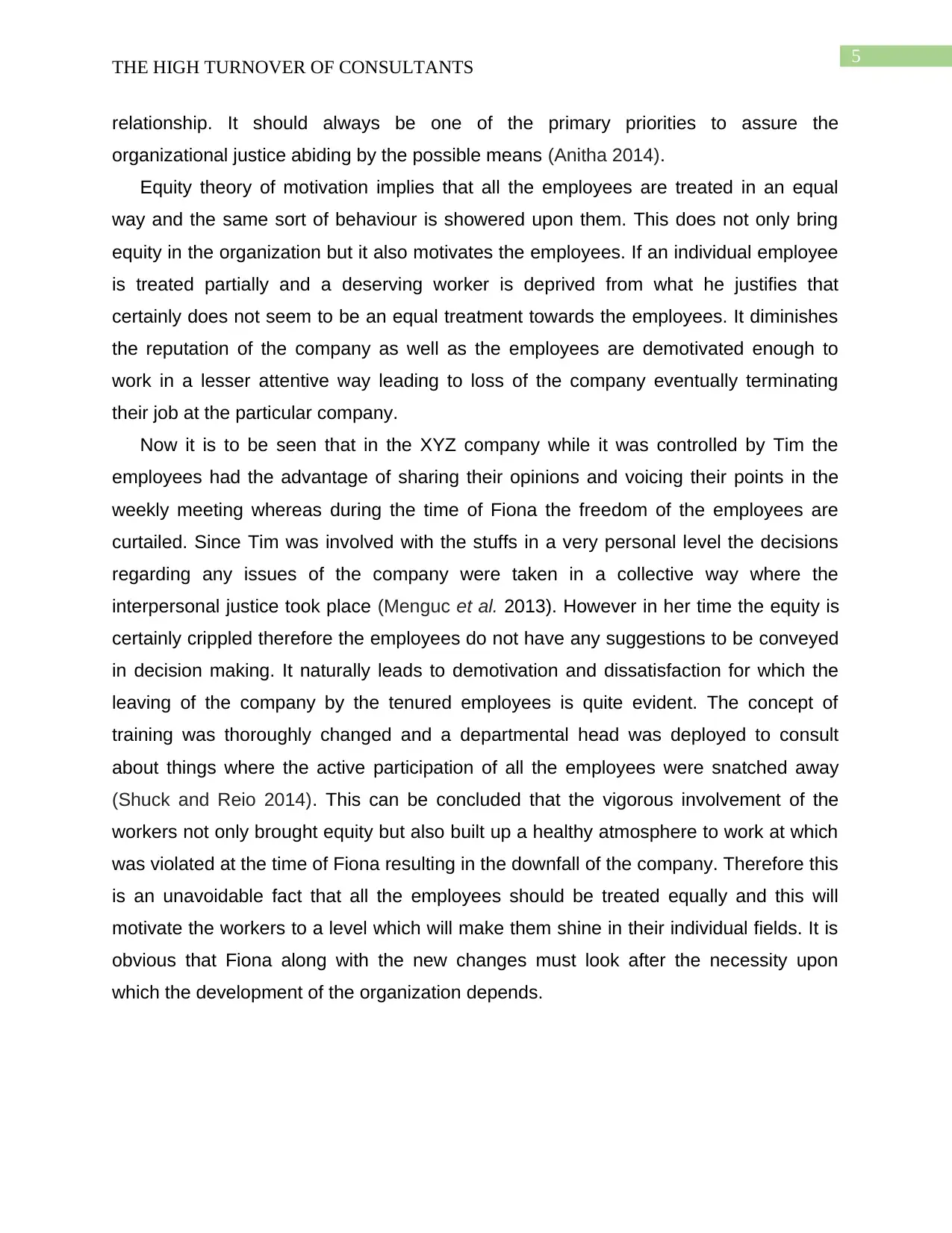
5
THE HIGH TURNOVER OF CONSULTANTS
relationship. It should always be one of the primary priorities to assure the
organizational justice abiding by the possible means (Anitha 2014).
Equity theory of motivation implies that all the employees are treated in an equal
way and the same sort of behaviour is showered upon them. This does not only bring
equity in the organization but it also motivates the employees. If an individual employee
is treated partially and a deserving worker is deprived from what he justifies that
certainly does not seem to be an equal treatment towards the employees. It diminishes
the reputation of the company as well as the employees are demotivated enough to
work in a lesser attentive way leading to loss of the company eventually terminating
their job at the particular company.
Now it is to be seen that in the XYZ company while it was controlled by Tim the
employees had the advantage of sharing their opinions and voicing their points in the
weekly meeting whereas during the time of Fiona the freedom of the employees are
curtailed. Since Tim was involved with the stuffs in a very personal level the decisions
regarding any issues of the company were taken in a collective way where the
interpersonal justice took place (Menguc et al. 2013). However in her time the equity is
certainly crippled therefore the employees do not have any suggestions to be conveyed
in decision making. It naturally leads to demotivation and dissatisfaction for which the
leaving of the company by the tenured employees is quite evident. The concept of
training was thoroughly changed and a departmental head was deployed to consult
about things where the active participation of all the employees were snatched away
(Shuck and Reio 2014). This can be concluded that the vigorous involvement of the
workers not only brought equity but also built up a healthy atmosphere to work at which
was violated at the time of Fiona resulting in the downfall of the company. Therefore this
is an unavoidable fact that all the employees should be treated equally and this will
motivate the workers to a level which will make them shine in their individual fields. It is
obvious that Fiona along with the new changes must look after the necessity upon
which the development of the organization depends.
THE HIGH TURNOVER OF CONSULTANTS
relationship. It should always be one of the primary priorities to assure the
organizational justice abiding by the possible means (Anitha 2014).
Equity theory of motivation implies that all the employees are treated in an equal
way and the same sort of behaviour is showered upon them. This does not only bring
equity in the organization but it also motivates the employees. If an individual employee
is treated partially and a deserving worker is deprived from what he justifies that
certainly does not seem to be an equal treatment towards the employees. It diminishes
the reputation of the company as well as the employees are demotivated enough to
work in a lesser attentive way leading to loss of the company eventually terminating
their job at the particular company.
Now it is to be seen that in the XYZ company while it was controlled by Tim the
employees had the advantage of sharing their opinions and voicing their points in the
weekly meeting whereas during the time of Fiona the freedom of the employees are
curtailed. Since Tim was involved with the stuffs in a very personal level the decisions
regarding any issues of the company were taken in a collective way where the
interpersonal justice took place (Menguc et al. 2013). However in her time the equity is
certainly crippled therefore the employees do not have any suggestions to be conveyed
in decision making. It naturally leads to demotivation and dissatisfaction for which the
leaving of the company by the tenured employees is quite evident. The concept of
training was thoroughly changed and a departmental head was deployed to consult
about things where the active participation of all the employees were snatched away
(Shuck and Reio 2014). This can be concluded that the vigorous involvement of the
workers not only brought equity but also built up a healthy atmosphere to work at which
was violated at the time of Fiona resulting in the downfall of the company. Therefore this
is an unavoidable fact that all the employees should be treated equally and this will
motivate the workers to a level which will make them shine in their individual fields. It is
obvious that Fiona along with the new changes must look after the necessity upon
which the development of the organization depends.
⊘ This is a preview!⊘
Do you want full access?
Subscribe today to unlock all pages.

Trusted by 1+ million students worldwide
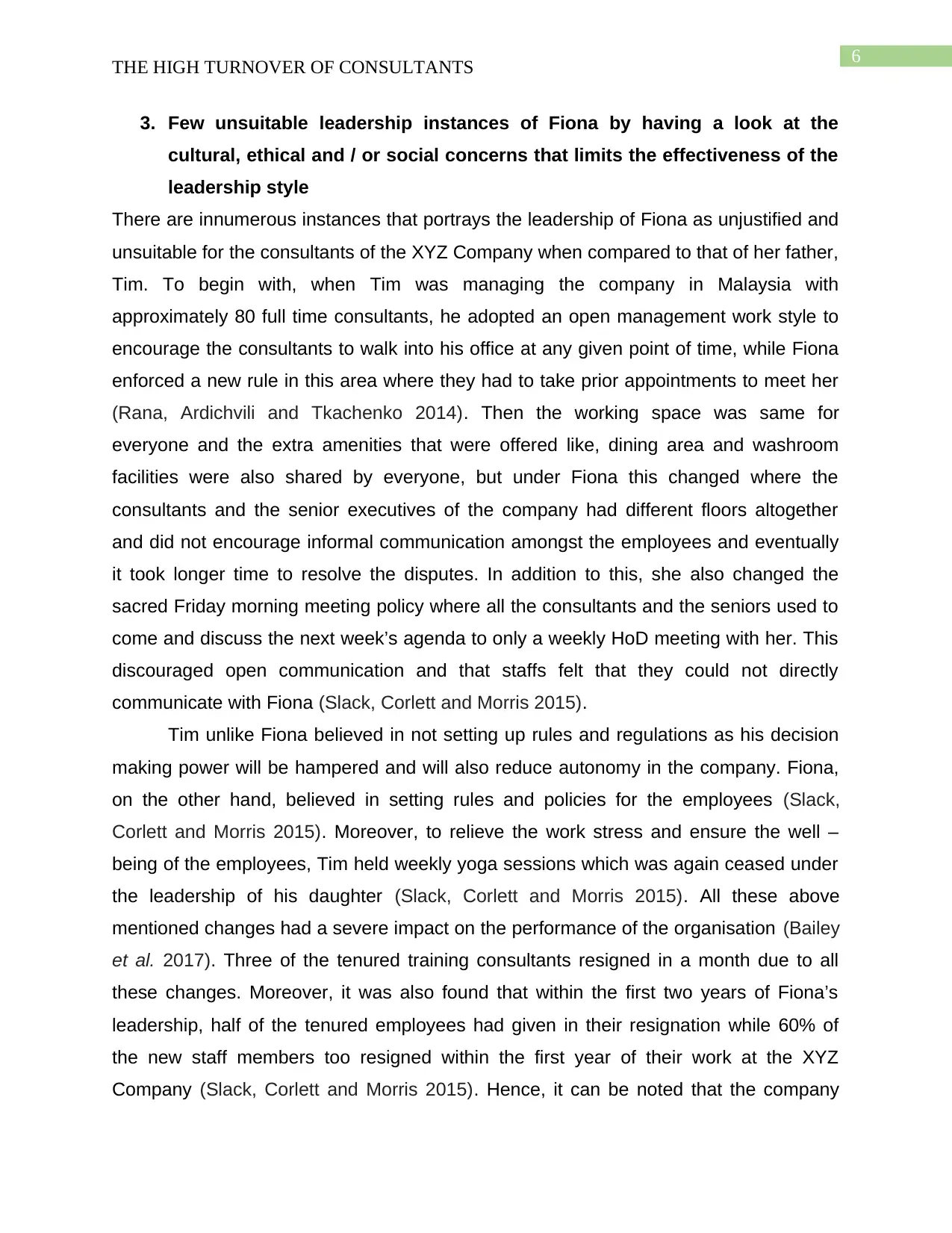
6
THE HIGH TURNOVER OF CONSULTANTS
3. Few unsuitable leadership instances of Fiona by having a look at the
cultural, ethical and / or social concerns that limits the effectiveness of the
leadership style
There are innumerous instances that portrays the leadership of Fiona as unjustified and
unsuitable for the consultants of the XYZ Company when compared to that of her father,
Tim. To begin with, when Tim was managing the company in Malaysia with
approximately 80 full time consultants, he adopted an open management work style to
encourage the consultants to walk into his office at any given point of time, while Fiona
enforced a new rule in this area where they had to take prior appointments to meet her
(Rana, Ardichvili and Tkachenko 2014). Then the working space was same for
everyone and the extra amenities that were offered like, dining area and washroom
facilities were also shared by everyone, but under Fiona this changed where the
consultants and the senior executives of the company had different floors altogether
and did not encourage informal communication amongst the employees and eventually
it took longer time to resolve the disputes. In addition to this, she also changed the
sacred Friday morning meeting policy where all the consultants and the seniors used to
come and discuss the next week’s agenda to only a weekly HoD meeting with her. This
discouraged open communication and that staffs felt that they could not directly
communicate with Fiona (Slack, Corlett and Morris 2015).
Tim unlike Fiona believed in not setting up rules and regulations as his decision
making power will be hampered and will also reduce autonomy in the company. Fiona,
on the other hand, believed in setting rules and policies for the employees (Slack,
Corlett and Morris 2015). Moreover, to relieve the work stress and ensure the well –
being of the employees, Tim held weekly yoga sessions which was again ceased under
the leadership of his daughter (Slack, Corlett and Morris 2015). All these above
mentioned changes had a severe impact on the performance of the organisation (Bailey
et al. 2017). Three of the tenured training consultants resigned in a month due to all
these changes. Moreover, it was also found that within the first two years of Fiona’s
leadership, half of the tenured employees had given in their resignation while 60% of
the new staff members too resigned within the first year of their work at the XYZ
Company (Slack, Corlett and Morris 2015). Hence, it can be noted that the company
THE HIGH TURNOVER OF CONSULTANTS
3. Few unsuitable leadership instances of Fiona by having a look at the
cultural, ethical and / or social concerns that limits the effectiveness of the
leadership style
There are innumerous instances that portrays the leadership of Fiona as unjustified and
unsuitable for the consultants of the XYZ Company when compared to that of her father,
Tim. To begin with, when Tim was managing the company in Malaysia with
approximately 80 full time consultants, he adopted an open management work style to
encourage the consultants to walk into his office at any given point of time, while Fiona
enforced a new rule in this area where they had to take prior appointments to meet her
(Rana, Ardichvili and Tkachenko 2014). Then the working space was same for
everyone and the extra amenities that were offered like, dining area and washroom
facilities were also shared by everyone, but under Fiona this changed where the
consultants and the senior executives of the company had different floors altogether
and did not encourage informal communication amongst the employees and eventually
it took longer time to resolve the disputes. In addition to this, she also changed the
sacred Friday morning meeting policy where all the consultants and the seniors used to
come and discuss the next week’s agenda to only a weekly HoD meeting with her. This
discouraged open communication and that staffs felt that they could not directly
communicate with Fiona (Slack, Corlett and Morris 2015).
Tim unlike Fiona believed in not setting up rules and regulations as his decision
making power will be hampered and will also reduce autonomy in the company. Fiona,
on the other hand, believed in setting rules and policies for the employees (Slack,
Corlett and Morris 2015). Moreover, to relieve the work stress and ensure the well –
being of the employees, Tim held weekly yoga sessions which was again ceased under
the leadership of his daughter (Slack, Corlett and Morris 2015). All these above
mentioned changes had a severe impact on the performance of the organisation (Bailey
et al. 2017). Three of the tenured training consultants resigned in a month due to all
these changes. Moreover, it was also found that within the first two years of Fiona’s
leadership, half of the tenured employees had given in their resignation while 60% of
the new staff members too resigned within the first year of their work at the XYZ
Company (Slack, Corlett and Morris 2015). Hence, it can be noted that the company
Paraphrase This Document
Need a fresh take? Get an instant paraphrase of this document with our AI Paraphraser
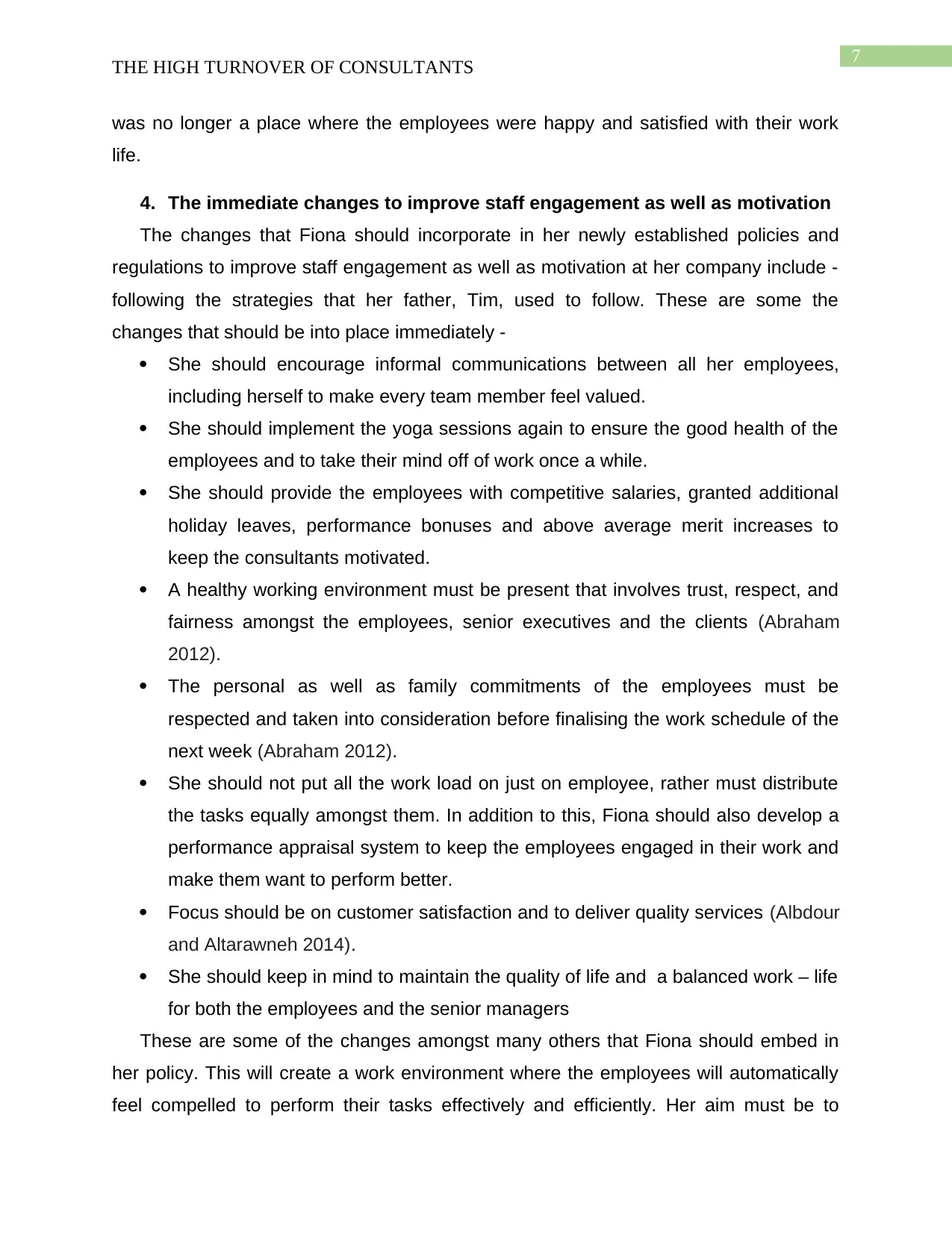
7
THE HIGH TURNOVER OF CONSULTANTS
was no longer a place where the employees were happy and satisfied with their work
life.
4. The immediate changes to improve staff engagement as well as motivation
The changes that Fiona should incorporate in her newly established policies and
regulations to improve staff engagement as well as motivation at her company include -
following the strategies that her father, Tim, used to follow. These are some the
changes that should be into place immediately -
She should encourage informal communications between all her employees,
including herself to make every team member feel valued.
She should implement the yoga sessions again to ensure the good health of the
employees and to take their mind off of work once a while.
She should provide the employees with competitive salaries, granted additional
holiday leaves, performance bonuses and above average merit increases to
keep the consultants motivated.
A healthy working environment must be present that involves trust, respect, and
fairness amongst the employees, senior executives and the clients (Abraham
2012).
The personal as well as family commitments of the employees must be
respected and taken into consideration before finalising the work schedule of the
next week (Abraham 2012).
She should not put all the work load on just on employee, rather must distribute
the tasks equally amongst them. In addition to this, Fiona should also develop a
performance appraisal system to keep the employees engaged in their work and
make them want to perform better.
Focus should be on customer satisfaction and to deliver quality services (Albdour
and Altarawneh 2014).
She should keep in mind to maintain the quality of life and a balanced work – life
for both the employees and the senior managers
These are some of the changes amongst many others that Fiona should embed in
her policy. This will create a work environment where the employees will automatically
feel compelled to perform their tasks effectively and efficiently. Her aim must be to
THE HIGH TURNOVER OF CONSULTANTS
was no longer a place where the employees were happy and satisfied with their work
life.
4. The immediate changes to improve staff engagement as well as motivation
The changes that Fiona should incorporate in her newly established policies and
regulations to improve staff engagement as well as motivation at her company include -
following the strategies that her father, Tim, used to follow. These are some the
changes that should be into place immediately -
She should encourage informal communications between all her employees,
including herself to make every team member feel valued.
She should implement the yoga sessions again to ensure the good health of the
employees and to take their mind off of work once a while.
She should provide the employees with competitive salaries, granted additional
holiday leaves, performance bonuses and above average merit increases to
keep the consultants motivated.
A healthy working environment must be present that involves trust, respect, and
fairness amongst the employees, senior executives and the clients (Abraham
2012).
The personal as well as family commitments of the employees must be
respected and taken into consideration before finalising the work schedule of the
next week (Abraham 2012).
She should not put all the work load on just on employee, rather must distribute
the tasks equally amongst them. In addition to this, Fiona should also develop a
performance appraisal system to keep the employees engaged in their work and
make them want to perform better.
Focus should be on customer satisfaction and to deliver quality services (Albdour
and Altarawneh 2014).
She should keep in mind to maintain the quality of life and a balanced work – life
for both the employees and the senior managers
These are some of the changes amongst many others that Fiona should embed in
her policy. This will create a work environment where the employees will automatically
feel compelled to perform their tasks effectively and efficiently. Her aim must be to
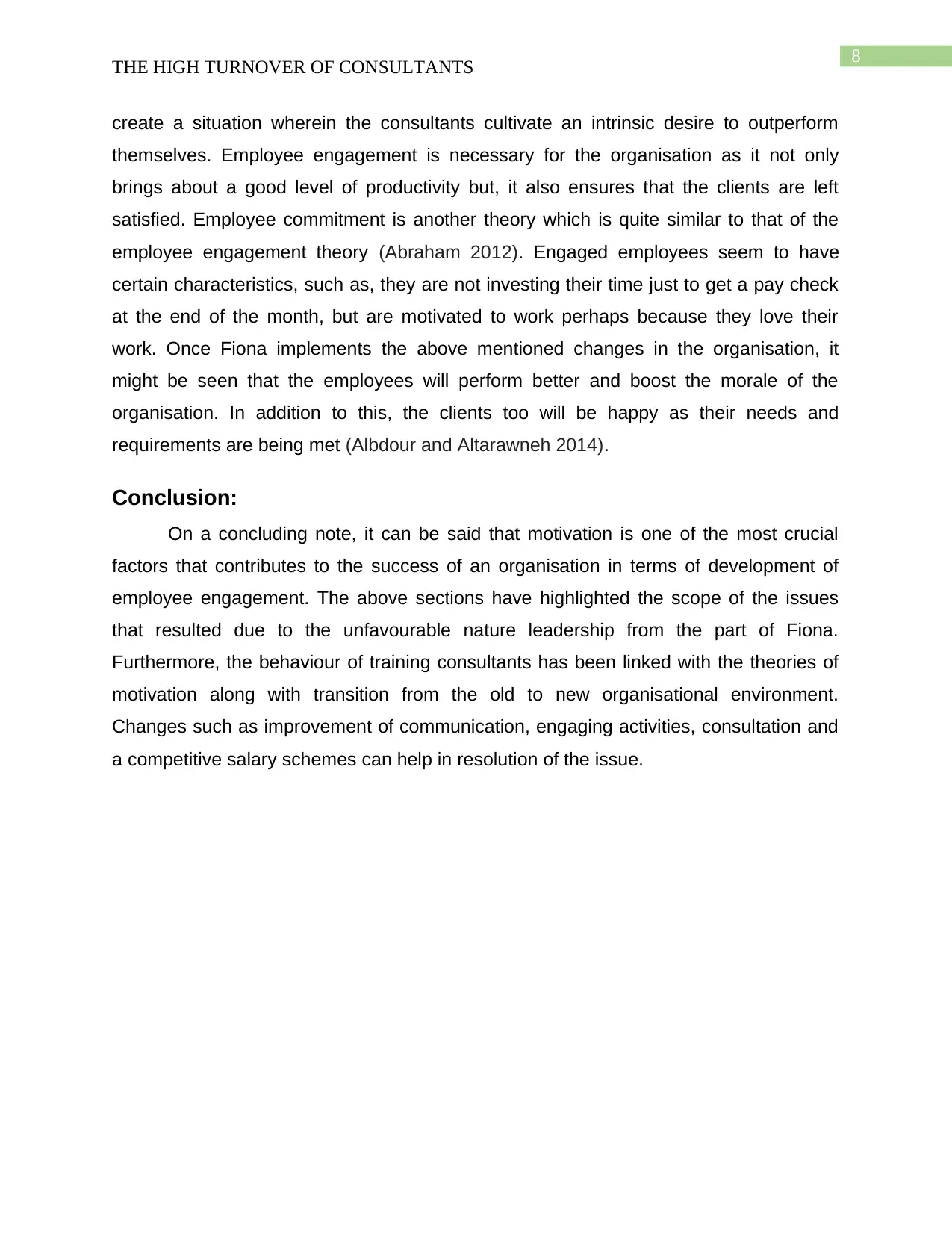
8
THE HIGH TURNOVER OF CONSULTANTS
create a situation wherein the consultants cultivate an intrinsic desire to outperform
themselves. Employee engagement is necessary for the organisation as it not only
brings about a good level of productivity but, it also ensures that the clients are left
satisfied. Employee commitment is another theory which is quite similar to that of the
employee engagement theory (Abraham 2012). Engaged employees seem to have
certain characteristics, such as, they are not investing their time just to get a pay check
at the end of the month, but are motivated to work perhaps because they love their
work. Once Fiona implements the above mentioned changes in the organisation, it
might be seen that the employees will perform better and boost the morale of the
organisation. In addition to this, the clients too will be happy as their needs and
requirements are being met (Albdour and Altarawneh 2014).
Conclusion:
On a concluding note, it can be said that motivation is one of the most crucial
factors that contributes to the success of an organisation in terms of development of
employee engagement. The above sections have highlighted the scope of the issues
that resulted due to the unfavourable nature leadership from the part of Fiona.
Furthermore, the behaviour of training consultants has been linked with the theories of
motivation along with transition from the old to new organisational environment.
Changes such as improvement of communication, engaging activities, consultation and
a competitive salary schemes can help in resolution of the issue.
THE HIGH TURNOVER OF CONSULTANTS
create a situation wherein the consultants cultivate an intrinsic desire to outperform
themselves. Employee engagement is necessary for the organisation as it not only
brings about a good level of productivity but, it also ensures that the clients are left
satisfied. Employee commitment is another theory which is quite similar to that of the
employee engagement theory (Abraham 2012). Engaged employees seem to have
certain characteristics, such as, they are not investing their time just to get a pay check
at the end of the month, but are motivated to work perhaps because they love their
work. Once Fiona implements the above mentioned changes in the organisation, it
might be seen that the employees will perform better and boost the morale of the
organisation. In addition to this, the clients too will be happy as their needs and
requirements are being met (Albdour and Altarawneh 2014).
Conclusion:
On a concluding note, it can be said that motivation is one of the most crucial
factors that contributes to the success of an organisation in terms of development of
employee engagement. The above sections have highlighted the scope of the issues
that resulted due to the unfavourable nature leadership from the part of Fiona.
Furthermore, the behaviour of training consultants has been linked with the theories of
motivation along with transition from the old to new organisational environment.
Changes such as improvement of communication, engaging activities, consultation and
a competitive salary schemes can help in resolution of the issue.
⊘ This is a preview!⊘
Do you want full access?
Subscribe today to unlock all pages.

Trusted by 1+ million students worldwide
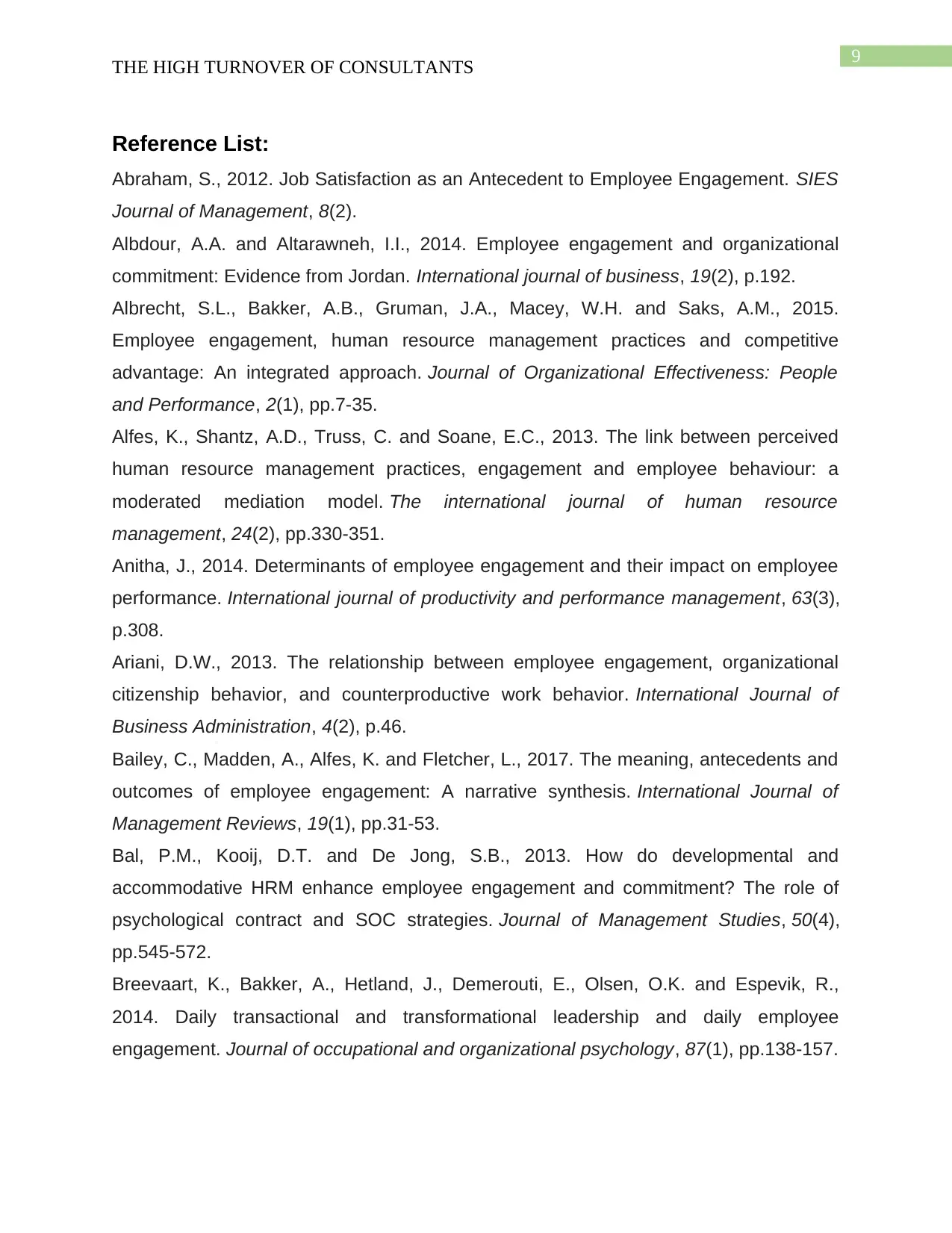
9
THE HIGH TURNOVER OF CONSULTANTS
Reference List:
Abraham, S., 2012. Job Satisfaction as an Antecedent to Employee Engagement. SIES
Journal of Management, 8(2).
Albdour, A.A. and Altarawneh, I.I., 2014. Employee engagement and organizational
commitment: Evidence from Jordan. International journal of business, 19(2), p.192.
Albrecht, S.L., Bakker, A.B., Gruman, J.A., Macey, W.H. and Saks, A.M., 2015.
Employee engagement, human resource management practices and competitive
advantage: An integrated approach. Journal of Organizational Effectiveness: People
and Performance, 2(1), pp.7-35.
Alfes, K., Shantz, A.D., Truss, C. and Soane, E.C., 2013. The link between perceived
human resource management practices, engagement and employee behaviour: a
moderated mediation model. The international journal of human resource
management, 24(2), pp.330-351.
Anitha, J., 2014. Determinants of employee engagement and their impact on employee
performance. International journal of productivity and performance management, 63(3),
p.308.
Ariani, D.W., 2013. The relationship between employee engagement, organizational
citizenship behavior, and counterproductive work behavior. International Journal of
Business Administration, 4(2), p.46.
Bailey, C., Madden, A., Alfes, K. and Fletcher, L., 2017. The meaning, antecedents and
outcomes of employee engagement: A narrative synthesis. International Journal of
Management Reviews, 19(1), pp.31-53.
Bal, P.M., Kooij, D.T. and De Jong, S.B., 2013. How do developmental and
accommodative HRM enhance employee engagement and commitment? The role of
psychological contract and SOC strategies. Journal of Management Studies, 50(4),
pp.545-572.
Breevaart, K., Bakker, A., Hetland, J., Demerouti, E., Olsen, O.K. and Espevik, R.,
2014. Daily transactional and transformational leadership and daily employee
engagement. Journal of occupational and organizational psychology, 87(1), pp.138-157.
THE HIGH TURNOVER OF CONSULTANTS
Reference List:
Abraham, S., 2012. Job Satisfaction as an Antecedent to Employee Engagement. SIES
Journal of Management, 8(2).
Albdour, A.A. and Altarawneh, I.I., 2014. Employee engagement and organizational
commitment: Evidence from Jordan. International journal of business, 19(2), p.192.
Albrecht, S.L., Bakker, A.B., Gruman, J.A., Macey, W.H. and Saks, A.M., 2015.
Employee engagement, human resource management practices and competitive
advantage: An integrated approach. Journal of Organizational Effectiveness: People
and Performance, 2(1), pp.7-35.
Alfes, K., Shantz, A.D., Truss, C. and Soane, E.C., 2013. The link between perceived
human resource management practices, engagement and employee behaviour: a
moderated mediation model. The international journal of human resource
management, 24(2), pp.330-351.
Anitha, J., 2014. Determinants of employee engagement and their impact on employee
performance. International journal of productivity and performance management, 63(3),
p.308.
Ariani, D.W., 2013. The relationship between employee engagement, organizational
citizenship behavior, and counterproductive work behavior. International Journal of
Business Administration, 4(2), p.46.
Bailey, C., Madden, A., Alfes, K. and Fletcher, L., 2017. The meaning, antecedents and
outcomes of employee engagement: A narrative synthesis. International Journal of
Management Reviews, 19(1), pp.31-53.
Bal, P.M., Kooij, D.T. and De Jong, S.B., 2013. How do developmental and
accommodative HRM enhance employee engagement and commitment? The role of
psychological contract and SOC strategies. Journal of Management Studies, 50(4),
pp.545-572.
Breevaart, K., Bakker, A., Hetland, J., Demerouti, E., Olsen, O.K. and Espevik, R.,
2014. Daily transactional and transformational leadership and daily employee
engagement. Journal of occupational and organizational psychology, 87(1), pp.138-157.
Paraphrase This Document
Need a fresh take? Get an instant paraphrase of this document with our AI Paraphraser
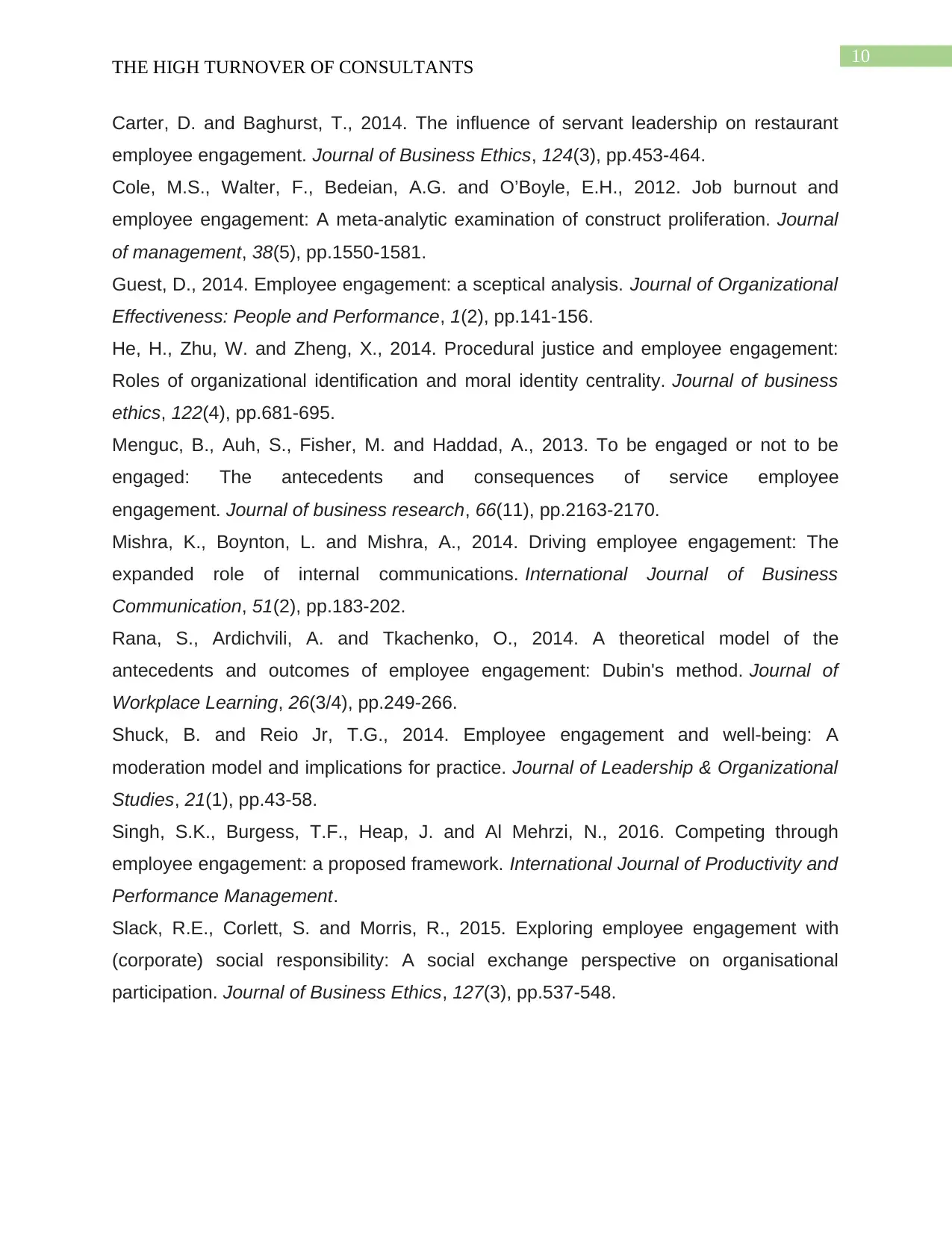
10
THE HIGH TURNOVER OF CONSULTANTS
Carter, D. and Baghurst, T., 2014. The influence of servant leadership on restaurant
employee engagement. Journal of Business Ethics, 124(3), pp.453-464.
Cole, M.S., Walter, F., Bedeian, A.G. and O’Boyle, E.H., 2012. Job burnout and
employee engagement: A meta-analytic examination of construct proliferation. Journal
of management, 38(5), pp.1550-1581.
Guest, D., 2014. Employee engagement: a sceptical analysis. Journal of Organizational
Effectiveness: People and Performance, 1(2), pp.141-156.
He, H., Zhu, W. and Zheng, X., 2014. Procedural justice and employee engagement:
Roles of organizational identification and moral identity centrality. Journal of business
ethics, 122(4), pp.681-695.
Menguc, B., Auh, S., Fisher, M. and Haddad, A., 2013. To be engaged or not to be
engaged: The antecedents and consequences of service employee
engagement. Journal of business research, 66(11), pp.2163-2170.
Mishra, K., Boynton, L. and Mishra, A., 2014. Driving employee engagement: The
expanded role of internal communications. International Journal of Business
Communication, 51(2), pp.183-202.
Rana, S., Ardichvili, A. and Tkachenko, O., 2014. A theoretical model of the
antecedents and outcomes of employee engagement: Dubin's method. Journal of
Workplace Learning, 26(3/4), pp.249-266.
Shuck, B. and Reio Jr, T.G., 2014. Employee engagement and well-being: A
moderation model and implications for practice. Journal of Leadership & Organizational
Studies, 21(1), pp.43-58.
Singh, S.K., Burgess, T.F., Heap, J. and Al Mehrzi, N., 2016. Competing through
employee engagement: a proposed framework. International Journal of Productivity and
Performance Management.
Slack, R.E., Corlett, S. and Morris, R., 2015. Exploring employee engagement with
(corporate) social responsibility: A social exchange perspective on organisational
participation. Journal of Business Ethics, 127(3), pp.537-548.
THE HIGH TURNOVER OF CONSULTANTS
Carter, D. and Baghurst, T., 2014. The influence of servant leadership on restaurant
employee engagement. Journal of Business Ethics, 124(3), pp.453-464.
Cole, M.S., Walter, F., Bedeian, A.G. and O’Boyle, E.H., 2012. Job burnout and
employee engagement: A meta-analytic examination of construct proliferation. Journal
of management, 38(5), pp.1550-1581.
Guest, D., 2014. Employee engagement: a sceptical analysis. Journal of Organizational
Effectiveness: People and Performance, 1(2), pp.141-156.
He, H., Zhu, W. and Zheng, X., 2014. Procedural justice and employee engagement:
Roles of organizational identification and moral identity centrality. Journal of business
ethics, 122(4), pp.681-695.
Menguc, B., Auh, S., Fisher, M. and Haddad, A., 2013. To be engaged or not to be
engaged: The antecedents and consequences of service employee
engagement. Journal of business research, 66(11), pp.2163-2170.
Mishra, K., Boynton, L. and Mishra, A., 2014. Driving employee engagement: The
expanded role of internal communications. International Journal of Business
Communication, 51(2), pp.183-202.
Rana, S., Ardichvili, A. and Tkachenko, O., 2014. A theoretical model of the
antecedents and outcomes of employee engagement: Dubin's method. Journal of
Workplace Learning, 26(3/4), pp.249-266.
Shuck, B. and Reio Jr, T.G., 2014. Employee engagement and well-being: A
moderation model and implications for practice. Journal of Leadership & Organizational
Studies, 21(1), pp.43-58.
Singh, S.K., Burgess, T.F., Heap, J. and Al Mehrzi, N., 2016. Competing through
employee engagement: a proposed framework. International Journal of Productivity and
Performance Management.
Slack, R.E., Corlett, S. and Morris, R., 2015. Exploring employee engagement with
(corporate) social responsibility: A social exchange perspective on organisational
participation. Journal of Business Ethics, 127(3), pp.537-548.
1 out of 11
Related Documents
Your All-in-One AI-Powered Toolkit for Academic Success.
+13062052269
info@desklib.com
Available 24*7 on WhatsApp / Email
![[object Object]](/_next/static/media/star-bottom.7253800d.svg)
Unlock your academic potential
Copyright © 2020–2025 A2Z Services. All Rights Reserved. Developed and managed by ZUCOL.





